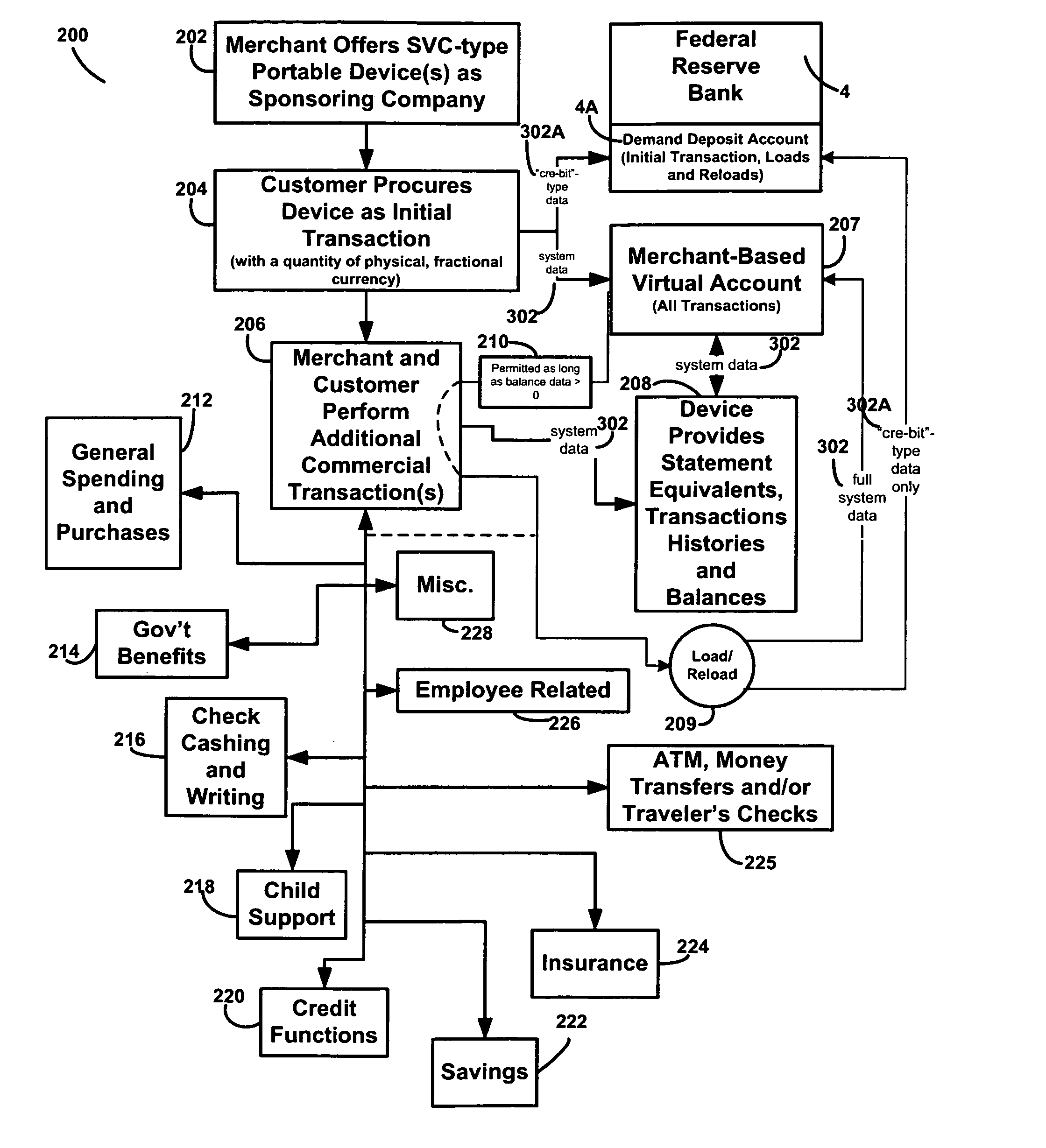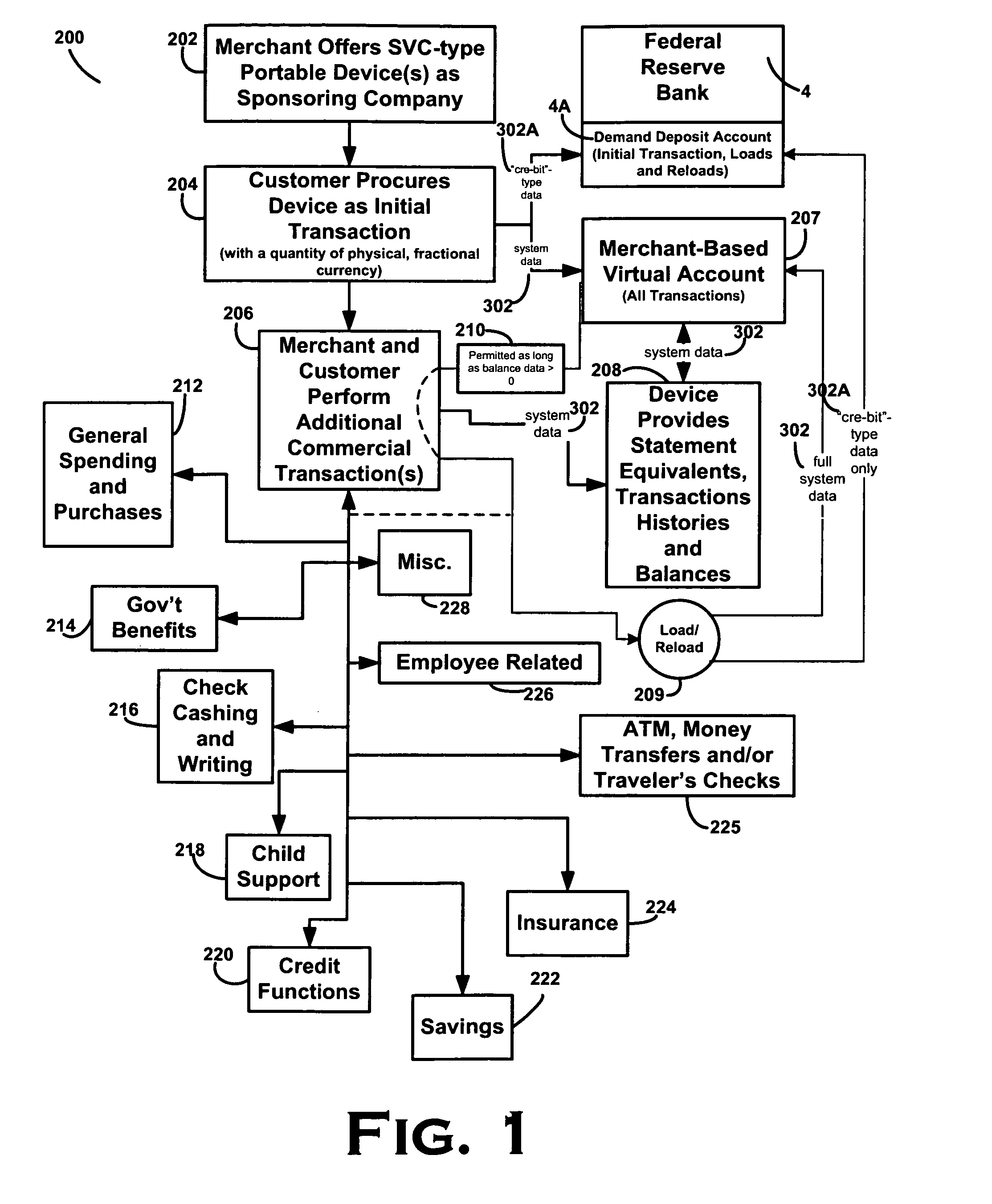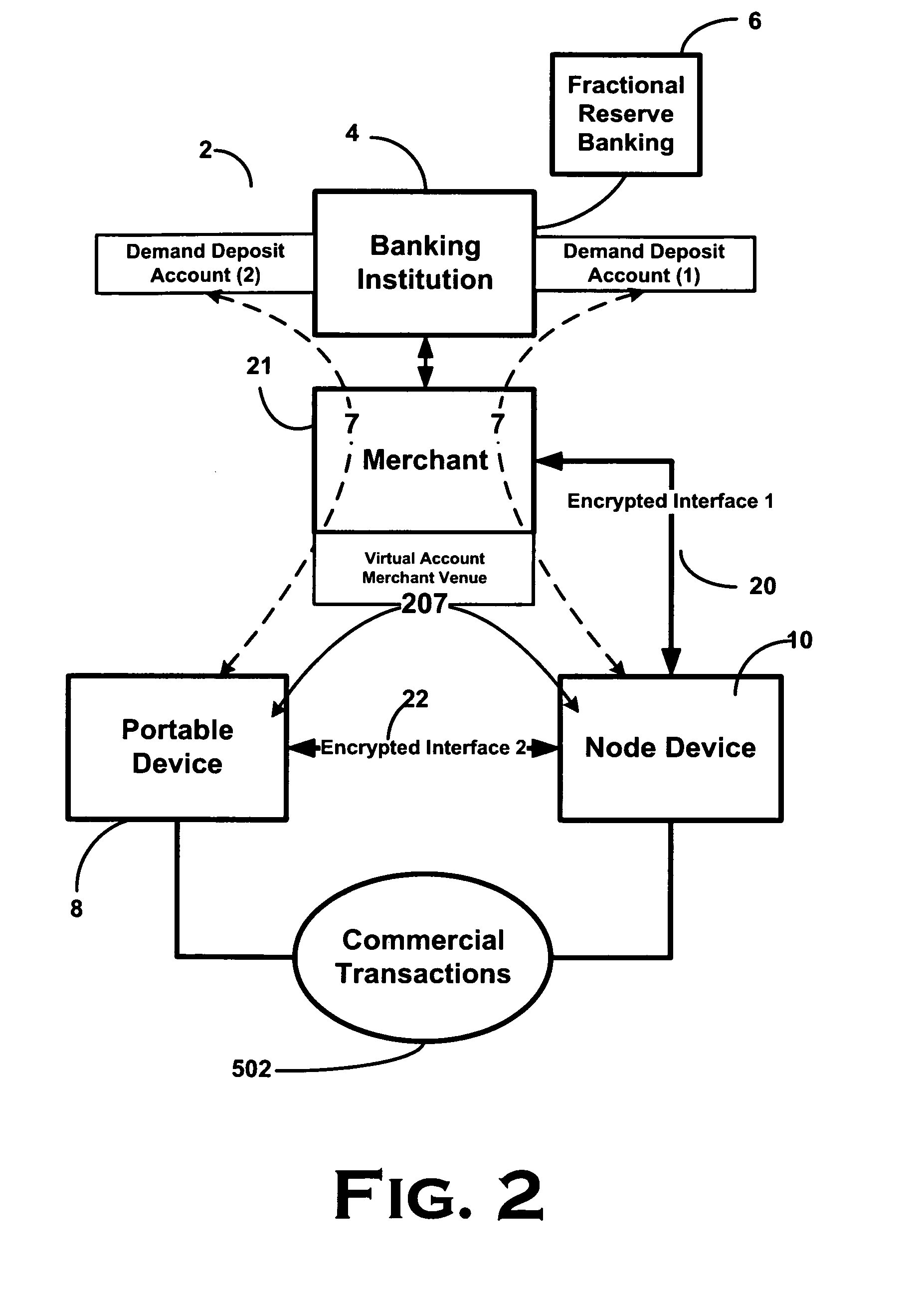While “good credit” and a banking history are both prerequisites to receiving a “
credit card,” only a banking history is needed for the use of “debit cards.” Yet,
debit card transactions carry
bank-regulated transaction fees, and are generally not employable by the increasing number of so-called “unbanked” and “underbanked.” The “
stored value card” has emerged as a transactional medium that crosses all socio-economic divides, is viable for the vast amount of
consumer transactions, and carries few if any transactional fees typically associated with both credit and debit cards.
Additionally, driven by this changing marketplace and enhanced by the strides in
computer technology, data communication and storage, banks and large-scale merchants can easily provide a whole panoply of overlapping transactional services, but are largely impeded by a
system that appears to hold firmly to a legally-imposed banking monopoly, rooted in its original need to process tangible fractional currency, now appearing archaic to the objective technologist yet customary in the anthropological view of the human form of commercial exchange.
While the volume of money that passes through this class is large, it also comprises bulky physical fractional currency.
Thus, banks cannot utilize such money (as it rarely navigates to demand deposit accounts but rather appears to be in “circulation”), and merchants must pay to
cart the currency about, with little ability to actually grow such households into the world of “bankable” and transactions into the world of electronic.
Lying behind this array of elements is a fairly well-established, yet unwieldy banking
system, including fractional-reserve banking, which has been established over a multiplicity of years, but yearns to grow to meet these newly developing demands.
Many banks are anxious to capture this customer base, but both customers and banks are concerned with risks inherent in becoming “banked.” Typically, such “unbanked” customers use a myriad of check-cashing facilities to liquidate their paychecks and then to use the cash thereby received.
One of the deeper concerns expressed therein is that the nature of stored value cards (“SVC's”) does not permit the
consumer to create credit portfolios, resulting, at least in part, from the inability of SVC-based systems to render account statements and maintain transactional information.
Furthermore,
regulatory authority and limits are not fully clear, or even necessarily implicated, where a merchant acts in the capacity of a virtual
bank in the provision of a certain panoply of services, perhaps greater in scope and security than an actual regulated bank.
Recently, however, the
credit card industry has been changing in that some merchants are now large enough to exert their own leverage (like Wal-Mart), legal defeats have impeded the ability of
credit card associations to control the market, and some participants have developed new arrangements and alliances that may be a prelude to further changes in the industry.
At that time, banking laws placed severe geographic restrictions on individual banks.
Virtually no banks were able to operate across state lines, and additional restrictions existed within many states.
As the network grew, the complexity of interchange—the movement of paper sales slips and settlement payments between member banks—became hard to manage.
Among the challenges each of these networks faced was bringing together large numbers of cardholders with large numbers of merchants who accepted the cards as
payment.
Achieving a sufficiently large network was hard, partly because merchants, especially larger retailers, were reluctant to honor credit cards that would compete with their own store-branded credit cards.
Inasmuch as the customer is left to pick without regard to the costs to the merchant, the differing fees charged to merchants for transacting PIN debits and signature debits has became the basis for conflict and
resultant litigation.
At the same time, interchange fees are a source of
irritation to merchants and can be among the largest and largest-growing costs of doing business for many retailers.
Large merchants can negotiate directly with the
card association for very low interchange fees, but these fees are not publicly circulated.
The pricing structure of interchange fees is complex.
There is considerable friction among network participants over the issue of interchange fees, and card associations are being challenged on the structure and application of those fees.
Merchants increasingly view interchange fees as an unnecessary and growing cost over which they have no control.
Furthermore, banks are now issuing credit cards with even higher interchange fees.
Merchants are unable to refuse transactions made with these cards.
In addition, Visa and
MasterCard have been forced to defend the interchange arrangement from litigation filed in June 2005 by a group of smaller merchants.
While styled as a gracious gesture, the harsh reality is that the consumer would rather give away what appears to be trivial than face the nuisance associated with carrying the same.
Moreover, as a result of the perceived substantial dissimilarity in value of individual coins (in comparison to large tranches of higher valued paper dollars), the perceived inconvenience of bulky currency has resulted in adults—not children—literally dumping their pockets at days end into containers (baskets, buckets, jars and the like), rarely to be seen or used by anyone again.
Considering the heft of the containers and a cost for the transaction, one might determine that all those storage containers are not really worth the effort.
Antithetically, a number of devices still require the use of coinage for operation.
(Some “smart” vending machines permit the use of debit or credit cards, but the technical interface is difficult to humanize, and market entry has been limited.
This, of course, creates a never-ending burden on, for example, a street vendor
proximate to an array of parking meters, to keep a stock
pile of coins for swapping for dollars—of zero net sum
gain—or, in the alternative, to almost rudely deny the desperate requestor who has parked and is racing to avoid the
ticket.
Rarely does the consumer actually prepare for the event, but rather, disturbingly, must face coinage at the time of the occurrence.
The need to provide fractional currency in commercial transactions—which is heretofore solely in the form of
metal or paper—is a constant, nagging, expensive, repetitive problem to many retail establishments.
Likewise, at the merchant end, a plethora of other problems arise in connection with physical, fractional currency transactions.
Indeed, there is a reported lawsuit concerning unfair credit card usage charges to such merchant / retailers in a drive to reduce this mechanized approach—with limited value added—because of the huge loss in revenue to the merchant as a result thereof.
Even here, however, gift cards have a remaining balance (small as it may be) not easily recoverable to the consumer.
Considering the disparate value between paper and coinage, the sheer bulk of such coinage is overwhelming, and the value staggering, heretofore beyond the control of the banking institutions, and adding expenses in the requirement of bulk-handling to the merchants.
Previously, metals had to be weighed in order to determine value, and that made trade more difficult.
In the course of their trade, the merchants began to extend credit to their customers, and in the case of these great banking families, the credit or “banking” part of their operations eventually overshadowed their mercantile activities.
The problem with the investment bankers is that one of their major fields of investment was the underwriting of government bonds, which plunged them hip-deep into politics, giving them a powerful incentive for pressuring and manipulating governments, so that taxes would be levied to pay off their and their clients' government bonds.
Unfortunately, while banks depend on the warehouse
perception, the fact is far more complicated.
Indeed, the money is not actually there at the warehouse.
Obviously, if bank 1 defaults, this system could collapse.
Hence, without government support and
enforcement, there would be only a limited scope for fractional-reserve banking.
Banks could form cartels to prop each other up, but generally cartels on the market fail without government
enforcement, without the government
cracking down on competitors who insist on busting the cartel, in this case, forcing a run on competing banks, by having their customers demand a full pay out from their accounts.
 Login to View More
Login to View More  Login to View More
Login to View More 


